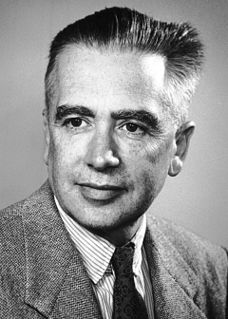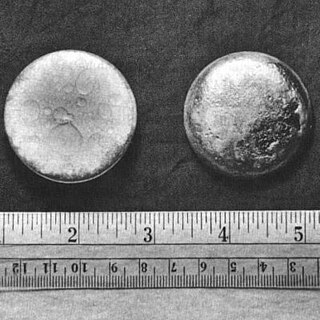Related Research Articles
The actinide or actinoid series encompasses the 15 metallic chemical elements with atomic numbers from 89 to 103, actinium through lawrencium.

Dubnium is a synthetic chemical element with the symbol Db and atomic number 105. Dubnium is highly radioactive: the most stable known isotope, dubnium-268, has a half-life of about 28 hours. This greatly limits the extent of research on dubnium.

Einsteinium is a synthetic element with the symbol Es and atomic number 99. As a member of the actinide series, it is the seventh transuranic element.

Enrico Fermi was an Italian-born physicist and the creator of the world's first nuclear reactor, the Chicago Pile-1. He has been called the "architect of the nuclear age" and the "architect of the atomic bomb". He was one of very few physicists to excel in both theoretical physics and experimental physics. Fermi held several patents related to the use of nuclear power, and was awarded the 1938 Nobel Prize in Physics for his work on induced radioactivity by neutron bombardment and for the discovery of transuranium elements. He made significant contributions to the development of statistical mechanics, quantum theory, and nuclear and particle physics.

Fermium is a synthetic element with the symbol Fm and atomic number 100. It is an actinide and the heaviest element that can be formed by neutron bombardment of lighter elements, and hence the last element that can be prepared in macroscopic quantities, although pure fermium metal has not yet been prepared. A total of 19 isotopes are known, with 257Fm being the longest-lived with a half-life of 100.5 days.

Hassium is a chemical element with the symbol Hs and the atomic number 108. Hassium is highly radioactive; the most stable known isotope, 269Hs, has a half-life of approximately 16 seconds. One of its isotopes, 270Hs, has magic numbers of both protons and neutrons for deformed nuclei, which gives it greater stability against spontaneous fission. Hassium has been made only in laboratories in minuscule quantities; its possible occurrence in nature has been hypothesized but no natural hassium has been found so far.

Neptunium is a chemical element with the symbol Np and atomic number 93. A radioactive actinide metal, neptunium is the first transuranic element. Its position in the periodic table just after uranium, named after the planet Uranus, led to it being named after Neptune, the next planet beyond Uranus. A neptunium atom has 93 protons and 93 electrons, of which seven are valence electrons. Neptunium metal is silvery and tarnishes when exposed to air. The element occurs in three allotropic forms and it normally exhibits five oxidation states, ranging from +3 to +7. It is radioactive, poisonous, pyrophoric, and capable of accumulating in bones, which makes the handling of neptunium dangerous.

In nuclear physics and nuclear chemistry, nuclear fission is a nuclear reaction or a radioactive decay process in which the nucleus of an atom splits into two or more smaller, lighter nuclei. The fission process often produces gamma photons, and releases a very large amount of energy even by the energetic standards of radioactive decay.
The transuranium elements are the chemical elements with atomic numbers greater than 92, which is the atomic number of uranium. All of these elements are unstable and decay radioactively into other elements.

Franco Dino Rasetti was an Italian physicist who, together with Enrico Fermi, discovered key processes leading to nuclear fission. Rasetti refused to work on the Manhattan Project on moral grounds.

Emilio Gino Segrè was an Italian-American physicist and Nobel laureate, who discovered the elements technetium and astatine, and the antiproton, a subatomic antiparticle, for which he was awarded the Nobel Prize in Physics in 1959. From 1943 to 1946 he worked at the Los Alamos National Laboratory as a group leader for the Manhattan Project. He found in April 1944 that Thin Man, the proposed plutonium gun-type nuclear weapon, would not work because of the presence of plutonium-240 impurities.
Unbibium, also known as element 122 or eka-thorium, is the hypothetical chemical element in the periodic table with the placeholder symbol of Ubb and atomic number 122. Unbibium and Ubb are the temporary systematic IUPAC name and symbol respectively, which are used until the element is discovered, confirmed, and a permanent name is decided upon. In the periodic table of the elements, it is expected to follow unbiunium as the second element of the superactinides and the fourth element of the 8th period. Similarly to unbiunium, it is expected to fall within the range of the island of stability, potentially conferring additional stability on some isotopes, especially 306Ubb which is expected to have a magic number of neutrons (184).

Ida Noddack, néeTacke, was a German chemist and physicist. In 1934 she was the first to mention the idea later named nuclear fission. With her husband Walter Noddack and Otto Berg she discovered element 75, rhenium. She was nominated three times for the Nobel Prize in Chemistry.
Neptunium (93Np) is usually considered an artificial element, although trace quantities are found in nature, so a standard atomic weight cannot be given. Like all trace or artificial elements, it has no stable isotopes. The first isotope to be synthesized and identified was 239Np in 1940, produced by bombarding 238U with neutrons to produce 239U, which then underwent beta decay to 239Np.
Plutonium-240 is an isotope of plutonium formed when plutonium-239 captures a neutron. The detection of its spontaneous fission led to its discovery in 1944 at Los Alamos and had important consequences for the Manhattan Project.

Plutonium is a radioactive chemical element with the symbol Pu and atomic number 94. It is an actinide metal of silvery-gray appearance that tarnishes when exposed to air, and forms a dull coating when oxidized. The element normally exhibits six allotropes and four oxidation states. It reacts with carbon, halogens, nitrogen, silicon, and hydrogen. When exposed to moist air, it forms oxides and hydrides that can expand the sample up to 70% in volume, which in turn flake off as a powder that is pyrophoric. It is radioactive and can accumulate in bones, which makes the handling of plutonium dangerous.
Hesperium was the name assigned to the element with atomic number 94, now known as plutonium. It was named in Italian Esperio after a Greek name of Italy, Hesperia, "the land of the West". The same team assigned the name ausonium to element 93, after Ausonia, a poetic name of Italy. By comparison, uranium, the heaviest of the primordial elements, has atomic number 92.
Otto Berg was a German scientist. He is one of the scientists credited with discovering rhenium, the last element to be discovered having a stable isotope.
Bohemium was the name assigned to the element with atomic number 93, now known as neptunium, when its discovery was first incorrectly alleged. It was named after Bohemia.

The discovery of the neutron and its properties was central to the extraordinary developments in atomic physics in the first half of the 20th century. Early in the century, Ernest Rutherford developed a crude model of the atom, based on the gold foil experiment of Hans Geiger and Ernest Marsden. In this model, atoms had their mass and positive electric charge concentrated in a very small nucleus. By 1920 chemical isotopes had been discovered, the atomic masses had been determined to be (approximately) integer multiples of the mass of the hydrogen atom, and the atomic number had been identified as the charge on the nucleus. Throughout the 1920s, the nucleus was viewed as composed of combinations of protons and electrons, the two elementary particles known at the time, but that model presented several experimental and theoretical contradictions.
References
- ↑ Fermi, E. (1934). "Possible Production of Elements of Atomic Number Higher than 92". Nature. 133 (3372): 898–899. Bibcode:1934Natur.133..898F. doi: 10.1038/133898a0 .
- 1 2 3 Sime, Ruth Lewin (2000). "The Search for Transuranium Elements and the Discovery of Nuclear Fission". Physics in Perspective. 2 (1): 48–62. Bibcode:2000PhP.....2...48S. doi:10.1007/s000160050036.
- ↑ Noddack, Ida (1934). "Über das Element 93". Angewandte Chemie. 47 (37): 653. doi:10.1002/ange.19340473707.
- Element name etymologies. Retrieved February 23, 2010.
- Enrico Fermi, Artificial radioactivity produced by neutron bombardment, Nobel Lecture, December 12, 1938.